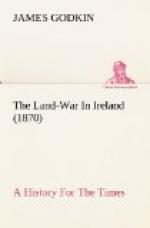In this way they hoped that ‘honest men’ would be encouraged to come and live amongst them, because the other three provinces (that is, all the island but Connaught) would be free of ‘tories,’ when there was none left to harbour or relieve them. They would have made a clean sweep of Munster, Leinster, and Ulster, so that ‘the saints’ might inherit the land without molestation. If any Protestant friends of the Irish objected to this thorough mode of effecting the work of Irish regeneration, Colonel Lawrence ’doubted not but God would enable that authority yet in being to let out that dram of rebellious bloud, and cure that fit of sullenness their advocate speaks of.’
The commissioners appointed to effect the transplantation were painfully conscious of their unworthiness to perform so holy a work, and Were overwhelmed with a sense of their weakness in the midst of such tremendous difficulties, so that they were constrained to say: ’The child is now come to the birth, and much is desired and expected, but there is no strength to bring forth.’ They therefore fasted and humbled themselves before the Lord, inviting the officers of the army to join them in lifting up prayers, ’with strong crying and tears, to Him to whom nothing is too strong, that His servants, whom He had called forth in this day to act in these great transactions, might be made faithful, and carried on by His own outstretched arm, against all opposition and difficulty, to do what was pleasing in His sight.’
It is true they had this consolation, ’that the chiefest and eminentest of the nobility and many of the gentry had taken conditions from the king of Spain, and had transported 40,000 of the most active, spirited men, most acquainted with the dangers and discipline of war.’ The priests were all banished. The remaining part of the whole nation was scarce one-sixth of what they were at the beginning of the war, so great a devastation had God and man brought upon that land; and that handful of natives left were poor labourers, simple creatures, whose sole design was to live and maintain their families.’
Of course there were many exceptions to this rule. There were some of the upper classes remaining, described in the certificates which all the emigrants were obliged to procure, like Sir Nicholas Comyn, of Limerick, ’who was numb at one side of his body of a dead palsy, accompanied only by his lady, Catherine Comyn, aged thirty-five years, flaxen-haired, middle stature; and one maid servant, Honor M’Namara, aged twenty years, brown hair, middle stature, having no substance,’ &c. From Tipperary went forth James, Lord Dunboyne, with 21 followers, and having 4 cows, 10 garrons, and 2 swine. Dame Catherine Morris, 35 followers, 10 cows, 16 garrons, 19 goats, 2 swine. Lady Mary Hamilton, of Roscrea, with 45 persons, 40 cows, 30 garrons, 46 sheep, 2 goats. Pierce, Lord Viscount Ikerrin, with 17 persons, having 16 acres of winter corn, 4 cows, 5 garrons, 14 sheep, 2 swine, &c.




